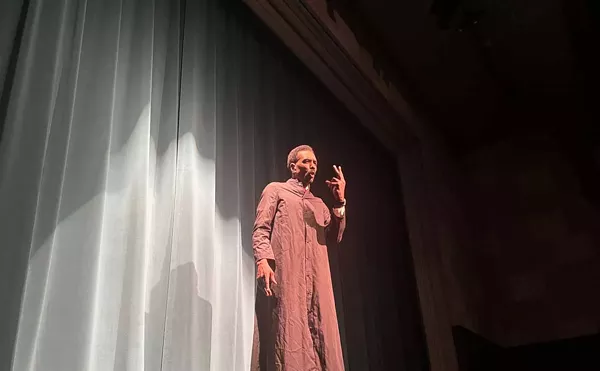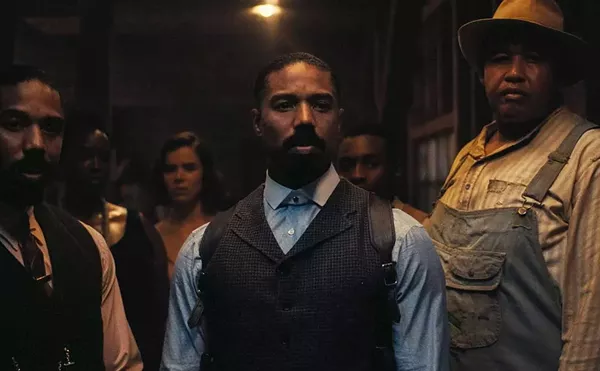
Audio By Carbonatix
[
{
"name": "GPT - Leaderboard - Inline - Content",
"component": "35519556",
"insertPoint": "5th",
"startingPoint": "3",
"requiredCountToDisplay": "3",
"maxInsertions": 100,
"adList": [
{
"adPreset": "LeaderboardInline"
}
]
}
]
A woman wearing painfully plain clothes is staring out of very freaked-out, unblinking eyes while sitting on a chair in front of Detroit artist Peter Williams’ painting on the second floor of New York City’s Whitney Museum of American Art. A small but intensely observant group clusters around her while one youngish fellow interrogates her. Why is she sitting in the middle of the 2002 Whitney Biennial Exhibition, the most talked about show in American art, the barometer of what’s happening on the national scene and running through May 26? She explains candidly that she’s doing a performance, entitled When I Close My Eyes, and is part of the exhibition. Some people wander off; others get closer. In the dim light, it slowly becomes apparent that her freaked-out eyes are painted on her eyelids. Her eyes are actually closed and she sits there for hours, not seeing, “not peeking” at the people with whom she is talking.
There’s a sense of intimacy with this figure that’s immediately established. You want to tell her what you feel as if she were a lifetime friend. She achieves some power, a weird disengaged objectivity that blindness gives her. The large painted eyes become a symbol of an all-seeing, all-knowing being, perfect for this show of shows. In her unhip schoolgirl clothes and sophomoric manner, Karin Campbell is, for now, more interesting than many an established midcareer artist.
I’m in New York to look at art — and especially to get out of Detroit and see what’s happening in our nation’s cultural fountainhead. While visiting other exhibitions in Manhattan, I think about Campbell’s performance and her artistic models, such as Vito Acconci. Hers is a simple conception, certainly no art in the performance, and it seems to sum up the 2002 Whitney Biennial where there are lots of cobbled-together components in the service of an idea, with a pre-emptive and provisional question mark that hangs over everything that seems to say, “How about this?” It’s a show in which artfulness is in the conception not the craftsmanship. Of course, there are 113 artists to think about, many of whom revel in exquisite craft and technological wizardry, and computer art and multimedia installations are abundant.
But in Campbell’s use of her own body as a medium and the simple equation of allowing the audience to complete the circuit, there’s a revelation about the state of contemporary art and the goals of this edition of the Biennial. Detroiter Williams’ paintings at first seem out of place by being too conscious of the traditions and history of art from which painting emerges. But he’s specifically awake to the juggling act he performs by being an African-American artist with a simultaneous sense of accomplished authority and a human vulnerability in his autobiographical paintings that he allows to be seen.
The mainstream art-journal critics are almost unanimous in their disdain for this year’s version of the Biennial. The mean-spirited, politically oriented criticism of the Whitney’s curator and director Lawrence R. Rinder’s catalog essay — and his often-quoted statement, “Time after time, I was told by the artists I met that, finally, they aimed for one thing alone, to represent the ‘truth’ as they knew it.” — would be, if not so desperate, funny. Art critics such as the New York Times’ Roberta Smith almost guffaw at Rinder’s desire to “reclaim the individual’s expressive capacity from the corporate monolith of mass-media entertainment.”
Peter Schjeldahl of the New Yorker sounds stodgy when reading Rinder’s assessment that artists “were looking for ways to sustain creative practices without concern for the art-market or art-world accolades.” Schjeldahl writes, “As it turns out, strained sincerity and negligible ambition dominate the show.”
But clearly Rinder saw something in the “43 cities and towns in 27 states” that he visited looking for artists, and it was precisely a kind of low-keyed resistance to market-driven art that’s keenly seen in such Detroit “community” art sites as Tangent Gallery, detroit contemporary, Alley Culture and Johanson Charles Gallery. Without exception there’s what Sherry Hendrick, curator of Alley Culture, refers to as a kind of “egolessness” and community-oriented culture that reminds her of the ’70s, when as artists “we were trying to maintain what little personal dignity was left to us.”
In the current installation at Alley Culture, Mike Slattery and Catherine Uehara have collaborated on an installation, Earth/After, that could easily be in the 2002 Whitney. It’s composed of tacky, found materials such as shopping bags with American flag logos, plastic blowup pine trees and AstroTurf cut into the shape of a United States map. This “post-installation installation,” while precisely without the formal properties that critics like Schjeldahl, Smith and Jerry Salz (of the Village Voice) have in mind when they call the Biennial “formless,” certainly brandishes a double-edged sword. It at once addresses our culture’s ecological and economic myopia as well as recycling pop iconography that is formidable and iconoclastic. This isn’t work that Smith will see in her meandering among Chelsea’s hot galleries that compelled her to say in a recent article in defense of painting, “Forget ‘shop until you drop’; look at paint until you faint.”
In a large space at the Whitney, a white-haired man is standing, looking up at Detroit collective Destroy All Monsters’ four-paneled mural, Strange Fruit: Rock Apocrypha, and with such keen interest that it seems he knows the figures in the panels (who include John Sinclair, Soupy Sales, Captain Jolly and Lester Bangs, to mention only a few of the Detroit luminaries depicted). With irony I ask him who these guys are, and he turns and says, “These are the heroes of one of the most interesting communities you can imagine — and I knew them.” He pauses and continues, “These are figures from a nutty, productive time in Detroit in the ’60s and ’70s, and I was there making art. The critics all said this was a bad show, but I’ve really been amazed by the inventiveness I’ve seen, from the top floor down.”
I finally recognize the speaker as Steve Foust, one of the most brilliant and inventive formalist artists of the Detroit Cass Corridor art community. Here at the Whitney, the murals of Destroy All Monsters (Mike Kelly, Cary Loren and Jim Shaw) somehow have a transcendent quality that celebrates the micronarrative of Detroit cultural production at a moment when artists still had the power to engage the culture on their own terms.
Anne Wilson, another Detroit artist in the exhibition, has installed a tantalizing tabletop surgical deconstruction of black lace, entitled Topologies, that seems a perfect model for the kind of subterranean cultural activity that the whole exhibition celebrates. Evoking notions of biological structures, fungal networks and the paradigm of quantum structure and chaos theory, her cartographical web of threads actively supports Rinder’s interest in emerging new forms.
When Williams was asked about his response to the mainstream critics’ assessment of the Biennial, he said, “It only reminded me how naked the emperor really is and how the agenda of the critics is determined by something else besides the art. When I talked to him, Rinder emphasized that there are no longer hierarchies of art; that painting isn’t the only model.”
There’s been a sea change in American culture and, as Rinder says in his catalog essay, it happened before Sept. 11. Williams, Wilson (both of whom are represented by Revolution Gallery in Ferndale) and the Destroy All Monsters collective are part of the Whitney not because of the genre they work in, but because their art deals with significant issues of identity and community, and the desperate needs of their constituency to be represented by new forms that are faithful to the fragmented nature of our decentralized lives.
Glen Mannisto writes about visual art for Metro Times. E-mail him at letters@metrotimes.com




